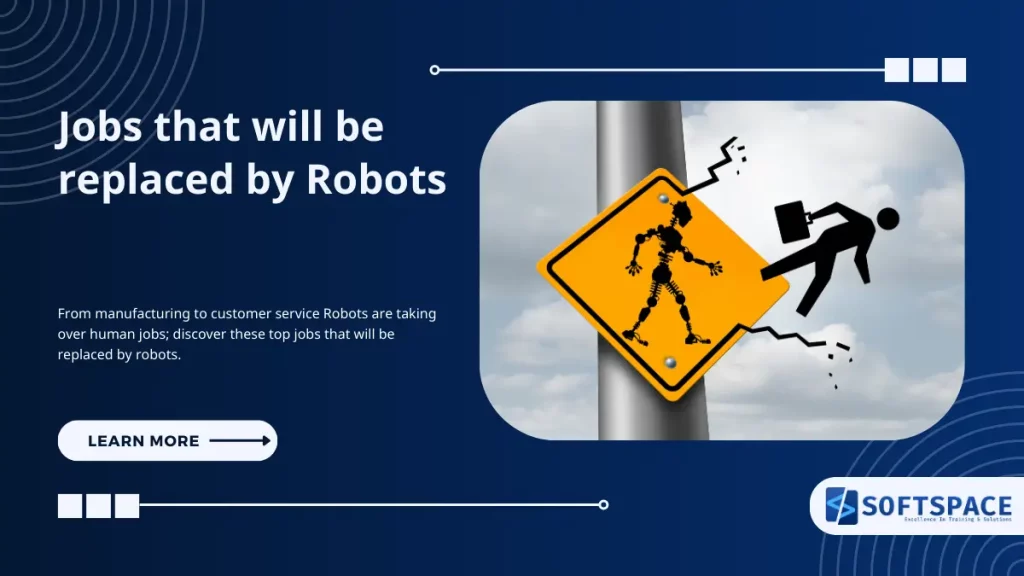The development of robotics and artificial intelligence has ushered in a new era of technological innovation. However, it raises a crucial question: which jobs will be replaced by robots? The job market is experiencing dramatic changes as machines become increasingly capable of performing tasks that were once thought to be exclusive to humans.
As technology advances, machines are now able to accomplish tasks that were previously considered solely human responsibilities. This leads us to an important question regarding which jobs are most at risk of being replaced by automation. In this blog post, we will discuss the jobs that will be replaced by robots in the coming years and explore how quickly automation has begun to replace human jobs thus far and its impact on employees.

What is robotic technology, and how is it useful in human job replacement?
Robotic technology includes the development, building, use, and maintenance of robots. Programmable machines that can do tasks automatically and frequently imitate human behaviour are called robots.
Numerous industries, such as manufacturing, healthcare, and logistics, have jobs that will be replaced by robots. Even if they can automate hazardous and tedious activities. But they also generate new employment opportunities in areas like maintenance and robotics engineering.
Why robots will replace jobs?
Due to their accuracy, speed, and unwavering work ethic, robotic technologies are increasingly attractive to companies seeking cost-effectiveness and efficiency. As a result, these robots will replace the human jobs. This automation has led to job displacement in various sectors, including manufacturing, shipping, customer service, and healthcare.
While this transition may result in job losses in certain areas, it also creates new positions focused on building, maintaining, and programming these machines. Below is the current statistic on jobs replaced by robots and its impact on employees.
Current statistics of Jobs replaced by robotic technologies along with its impact on employee
| Statistics | Impact on employee |
| 14% of people have already lost their jobs as a result of automation or artificial intelligence. | Many tasks inside employment are at risk, which could result in some workers losing their jobs even if not all jobs will be completely automated. |
| In 2024, 44% of AI-using businesses expect layoffs brought on by AI. | Automation may make occupations more competitive, which could result in decreased pay for some positions. |
| By 2025, AI may replace up to 85 million jobs globally. | In order to adjust to the evolving labour market, workers may need to learn new skills. |
| By 2030, automation may cause between 400 million and 800 million people to lose their jobs. | Losing a job and being unclear about the future can have a detrimental effect on mental health. |
Jobs that will be replaced by robots
Advanced robotics and artificial intelligence have the potential to completely transform a number of sectors by automating several functions that have historically been completed by humans. Due to this, human jobs will be replaced by robots.
Manufacturing, shipping, customer service, and data entry are among the “jobs that will be replaced by robots” because these industries can effectively manage repetitive, rule-based operations with the help of machines.
Manufacturing workers
The manufacturing sector is experiencing a major shift, propelled by the rising use of robotics. Tasks that were traditionally carried out by human employees on assembly lines are now more frequently executed by robots, especially in industries such as automotive and electronics.
How Robots are replacing manufacturing jobs
- Robots are highly effective at executing repetitive tasks with remarkable accuracy and speed, greatly outperforming human abilities. This capability leads to quicker production timelines and fewer mistakes.
- Robots can function in dangerous conditions, such as those involving hazardous chemicals or extreme temperatures, where the safety of humans may be compromised.
- Although the upfront cost of robotic systems can be considerable, they frequently provide long-term savings by enhancing efficiency, decreasing labour expenses, and minimising defect rates.
Percentage of manufacturing jobs replaced by robots
Current Estimates: 2023 research from the McKinsey Global Institute estimates that, as of right now, automation has automated about 12% of manufacturing employment worldwide.
Future Projections: According to the same estimate, automation may eliminate 400 million to 800 million jobs worldwide by 2030, with manufacturing being a major industry impacted.
Telemarketers and call centre agents
The rapid advancement of artificial intelligence (AI) is leading to a significant transformation in the customer service industry. AI-driven chatbots and virtual assistants are increasingly taking over the roles of human telemarketers and call centre representatives in their traditional functions. This shift will have a substantial impact on both the job market and the overall customer experience.
How Robots are replacing telemarketers and calc enter agents
- 24/7 Availability: Robotic systems are able to work around the clock, giving clients immediate assistance day or night.
- Efficiency: By managing several queries at once, robots can greatly boost productivity and cut down on wait times.
- Consistency: Robots reduce errors and raise customer satisfaction by guaranteeing consistent responses and following preset scripts.
- Cost-Effectiveness: Organisations can lower operating expenses related to recruiting and training human agents by automating repetitive work.
Current Stats on a telemarketer and call enter job replacement by robots
Robots are primarily used for routine tasks, not complex or emotional interactions.
Collaboration between humans and AI is widespread, with AI supporting human agents.
Future trends
Advanced Natural Language Processing (NLP): Robot systems will improve their comprehension and reaction to natural language, resulting in more human-like interactions.
Emotional AI: Robots that can identify and react to human emotions are being developed, allowing for more individualised and sympathetic consumer interactions.
Cashiers
As a result of the growing use of technology, the retail industry is changing dramatically. The emergence of automated payment systems and self-checkout kiosks, which are progressively displacing traditional cashier roles, is one of the most noticeable shifts.
Numerous causes, such as the desire for greater customer convenience, lower labour costs, and higher efficiency, are driving this move.
For example, customers can scan their products, bag them, and pay using a variety of methods, such as credit cards, debit cards, and mobile payments, at self-checkout kiosks. This lowers labour expenses for shops by doing away with the requirement for human cashiers to complete these duties.
How robots are replacing cashier duties
- Customers can scan their products, bag them, and pay with a variety of methods, such as credit cards, debit cards, and mobile payments, at self-checkout kiosks.
- Automated Payment Systems: By allowing consumers to place orders and make payments via touchscreens or smartphone apps, these systems—like those in fast-food restaurants—reduce the need for human cashiers.
- AI-Powered Cashiers: AI-powered robots are being created to carry out cashier tasks such as processing payments, scanning merchandise, and communicating with clients.
The current percentage of cashier jobs replaced by robots
Up to 30% of cashier positions have been replaced by robots
Future impact of robots in cashier duties
In the years to come, at least 50% of cashier employment may be replaced by robots. This is because of factors like:
- Cost-effectiveness: Automated systems can lower labour expenses while increasing operational effectiveness.
- Customer Preference: A lot of customers favour automated payment systems and self-checkout because of their quickness and convenience.
- Technological Developments: As AI and robots continue to improve, automation is becoming more complex and accessible.
Accountant
The accounting sector is changing because of AI-powered software that automates repetitive processes like financial reporting, tax preparation, and bookkeeping. In addition to improving accuracy and efficiency, this technology is allowing accountants to concentrate on more valuable and strategic tasks.
AI-powered software, for instance, can handle vast amounts of financial data fast and precisely, spot patterns and irregularities, and produce informative reports. This enables accountants to devote more time to financial performance analysis, strategic client consulting, and finding areas for revenue development and expense reduction.
It’s crucial to remember that software driven by AI cannot take the position of human accountants. Even if technology can automate a lot of tasks, human supervision and involvement are still necessary to guarantee accuracy and compliance.
Additionally, human professionals are better suited to perform numerous accounting jobs that require a thorough comprehension of intricate legislation, industry-specific intricacies, and client-specific needs.
- Data Processing and Entry:
Optical Character Recognition (OCR): By scanning and digitising paper documents such as bank statements, invoices, and receipts, robots can do away with the need for human data entry.
Machine Learning: AI systems are able to automatically classify and code transactions by identifying patterns in financial data.
- Reporting on finances:
Automated Report Generation: By generating common financial reports, such as balance sheets and income statements, robots can save time and cut down on errors.
Real-time Reporting: AI is able to evaluate financial data instantly, giving decision-makers the most recent information.
- Taxes preparations:
Filling Out Tax Forms: Robots can complete tax forms using the data they are given, which lowers the possibility of mistakes.
Tax Compliance: AI can keep an eye on tax laws and rules to make sure companies are staying in compliance.
Courier service
The growth of automation and robotics has had a big impact on courier services. Although they haven’t entirely replaced human couriers, robots have taken over some of the work and are progressively becoming more prevalent in this sector.
How robots are replacing courier service
- Autonomous Delivery Vehicles: Self-driving cars are being created to deliver packages to their locations without the need for human assistance. These cars can drive on sidewalks or on roads. The necessity for human couriers is decreased by these vehicles’ ability to run around the clock.
- Drones for delivery: Especially in crowded or isolated locations, drones are being utilised to deliver smaller products. They may transport packages straight to clients’ doorsteps while avoiding gridlock.
- Automation in Warehouses: Sorting, packing, and package transportation are among the operations that robots are being utilised to automate in warehouses. As a result, less human labour is required in these fields.
Conclusion
In conclusion, the workplace is changing dramatically as a result of the integration of robotics and artificial intelligence, which is transforming a number of industries. Although there are many advantages to these technologies, like numerous jobs that will be replaced by robots now with more productivity and efficiency, there are drawbacks as well, like job displacement.
Automation is particularly prevalent in the manufacturing, telemarketing, and customer service industries. Tasks that were once thought to be the sole purview of humans can now be performed by more complex robots. More employment may eventually be displaced by automation; therefore, this trend is probably here to stay.

13+ Yrs Experienced Career Counsellor & Skill Development Trainer | Educator | Digital & Content Strategist. Helping freshers and graduates make sound career choices through practical consultation. Guest faculty and Digital Marketing trainer working on building a skill development brand in Softspace Solutions. A passionate writer in core technical topics related to career growth.



